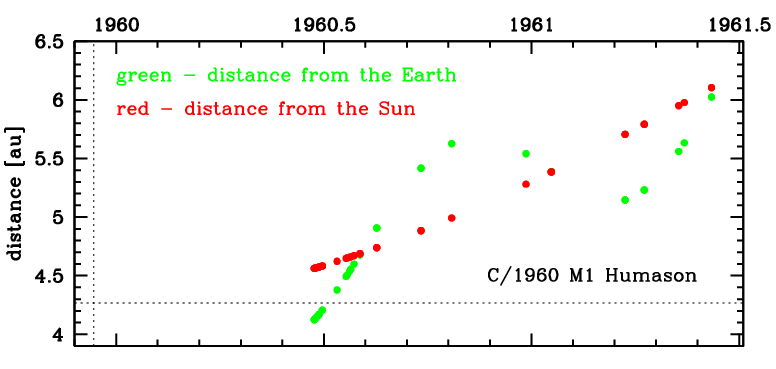C/1960 M1 Humason
more info
Comet C/1960 M1 was discovered on 18 June 1960, 6.5 months after perihelion passage, and was last seen on 7 June 1961 [Kronk and Meyer, Cometography: Volume 5].
The comet made its closest approach to the Earth on 16 May 1960 (3.91 au), about one month before discovery.
Solution given here is based on data spanning over 0.98 yr in a range of heliocentric distances from 4.56 au to 6.11 au.
This Oort spike comet suffers slight planetary perturbations during its passage through the planetary system but these perturbations can lead to escape of the comet from the solar system.
See also Królikowska and Dybczyński 2017.
The comet made its closest approach to the Earth on 16 May 1960 (3.91 au), about one month before discovery.
Solution given here is based on data spanning over 0.98 yr in a range of heliocentric distances from 4.56 au to 6.11 au.
This Oort spike comet suffers slight planetary perturbations during its passage through the planetary system but these perturbations can lead to escape of the comet from the solar system.
See also Królikowska and Dybczyński 2017.
| solution description | ||
|---|---|---|
| number of observations | 34 | |
| data interval | 1960 06 23 – 1961 06 07 | |
| data type | observed only after perihelion (POST) | |
| data arc selection | entire data set (STD) | |
| range of heliocentric distances | 4.56 au – 6.11au | |
| detectability of NG effects in the comet's motion | NG effects not determinable | |
| type of model of motion | GR - gravitational orbit | |
| data weighting | YES | |
| number of residuals | 65 | |
| RMS [arcseconds] | 1.42 | |
| orbit quality class | 1b | |
| orbital elements (heliocentric ecliptic J2000) | ||
|---|---|---|
| Epoch | 1959 12 18 | |
| perihelion date | 1959 12 11.21071907 | ± 0.00733102 |
| perihelion distance [au] | 4.26702674 | ± 0.00011122 |
| eccentricity | 1.00087137 | ± 0.00004611 |
| argument of perihelion [°] | 46.462683 | ± 0.002369 |
| ascending node [°] | 307.261873 | ± 0.000372 |
| inclination [°] | 125.469473 | ± 0.000071 |
| reciprocal semi-major axis [10-6 au-1] | -204.21 | ± 10.81 |
